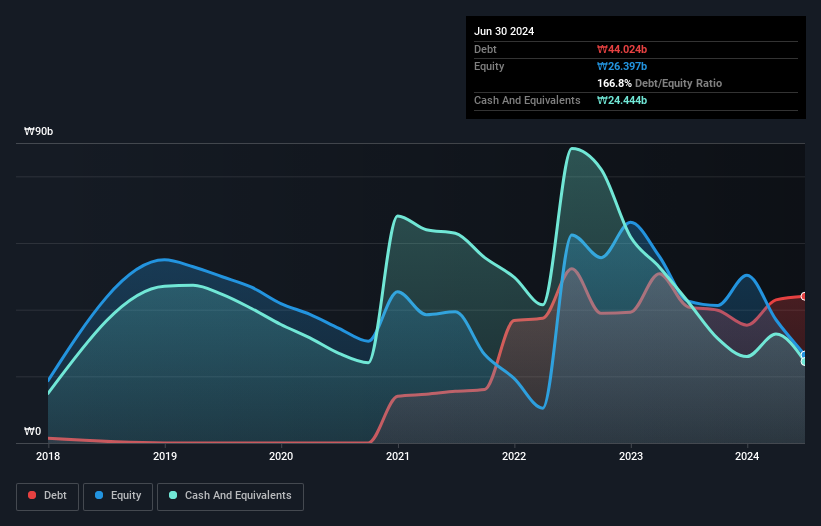- South Korea
- /
- Biotech
- /
- KOSDAQ:A226950
OliX Pharmaceuticals (KOSDAQ:226950) Is Making Moderate Use Of Debt

David Iben put it well when he said, 'Volatility is not a risk we care about. What we care about is avoiding the permanent loss of capital.' So it seems the smart money knows that debt - which is usually involved in bankruptcies - is a very important factor, when you assess how risky a company is. Importantly, OliX Pharmaceuticals, Inc (KOSDAQ:226950) does carry debt. But the more important question is: how much risk is that debt creating?
What Risk Does Debt Bring?
Debt assists a business until the business has trouble paying it off, either with new capital or with free cash flow. If things get really bad, the lenders can take control of the business. However, a more common (but still painful) scenario is that it has to raise new equity capital at a low price, thus permanently diluting shareholders. Of course, debt can be an important tool in businesses, particularly capital heavy businesses. The first thing to do when considering how much debt a business uses is to look at its cash and debt together.
Check out our latest analysis for OliX Pharmaceuticals
How Much Debt Does OliX Pharmaceuticals Carry?
As you can see below, at the end of June 2024, OliX Pharmaceuticals had ₩44.0b of debt, up from ₩40.8b a year ago. Click the image for more detail. However, it also had ₩24.4b in cash, and so its net debt is ₩19.6b.

How Healthy Is OliX Pharmaceuticals' Balance Sheet?
Zooming in on the latest balance sheet data, we can see that OliX Pharmaceuticals had liabilities of ₩31.3b due within 12 months and liabilities of ₩34.8b due beyond that. Offsetting this, it had ₩24.4b in cash and ₩2.48b in receivables that were due within 12 months. So its liabilities total ₩39.2b more than the combination of its cash and short-term receivables.
Of course, OliX Pharmaceuticals has a market capitalization of ₩375.8b, so these liabilities are probably manageable. Having said that, it's clear that we should continue to monitor its balance sheet, lest it change for the worse. There's no doubt that we learn most about debt from the balance sheet. But it is OliX Pharmaceuticals's earnings that will influence how the balance sheet holds up in the future. So if you're keen to discover more about its earnings, it might be worth checking out this graph of its long term earnings trend.
In the last year OliX Pharmaceuticals wasn't profitable at an EBIT level, but managed to grow its revenue by 85%, to ₩18b. Shareholders probably have their fingers crossed that it can grow its way to profits.
Caveat Emptor
Despite the top line growth, OliX Pharmaceuticals still had an earnings before interest and tax (EBIT) loss over the last year. To be specific the EBIT loss came in at ₩17b. Considering that alongside the liabilities mentioned above does not give us much confidence that company should be using so much debt. Quite frankly we think the balance sheet is far from match-fit, although it could be improved with time. However, it doesn't help that it burned through ₩29b of cash over the last year. So suffice it to say we consider the stock very risky. When analysing debt levels, the balance sheet is the obvious place to start. But ultimately, every company can contain risks that exist outside of the balance sheet. Be aware that OliX Pharmaceuticals is showing 4 warning signs in our investment analysis , and 3 of those are potentially serious...
Of course, if you're the type of investor who prefers buying stocks without the burden of debt, then don't hesitate to discover our exclusive list of net cash growth stocks, today.
If you're looking to trade OliX Pharmaceuticals, open an account with the lowest-cost platform trusted by professionals, Interactive Brokers.
With clients in over 200 countries and territories, and access to 160 markets, IBKR lets you trade stocks, options, futures, forex, bonds and funds from a single integrated account.
Enjoy no hidden fees, no account minimums, and FX conversion rates as low as 0.03%, far better than what most brokers offer.
Sponsored ContentNew: AI Stock Screener & Alerts
Our new AI Stock Screener scans the market every day to uncover opportunities.
• Dividend Powerhouses (3%+ Yield)
• Undervalued Small Caps with Insider Buying
• High growth Tech and AI Companies
Or build your own from over 50 metrics.
Have feedback on this article? Concerned about the content? Get in touch with us directly. Alternatively, email editorial-team (at) simplywallst.com.
This article by Simply Wall St is general in nature. We provide commentary based on historical data and analyst forecasts only using an unbiased methodology and our articles are not intended to be financial advice. It does not constitute a recommendation to buy or sell any stock, and does not take account of your objectives, or your financial situation. We aim to bring you long-term focused analysis driven by fundamental data. Note that our analysis may not factor in the latest price-sensitive company announcements or qualitative material. Simply Wall St has no position in any stocks mentioned.
About KOSDAQ:A226950
OliX Pharmaceuticals
A clinical stage pharmaceutical company, focuses on developing RNA interference (RNAi) therapeutics for dermal, ophthalmic, and pulmonary diseases.
Moderate with weak fundamentals.
Market Insights
Community Narratives



